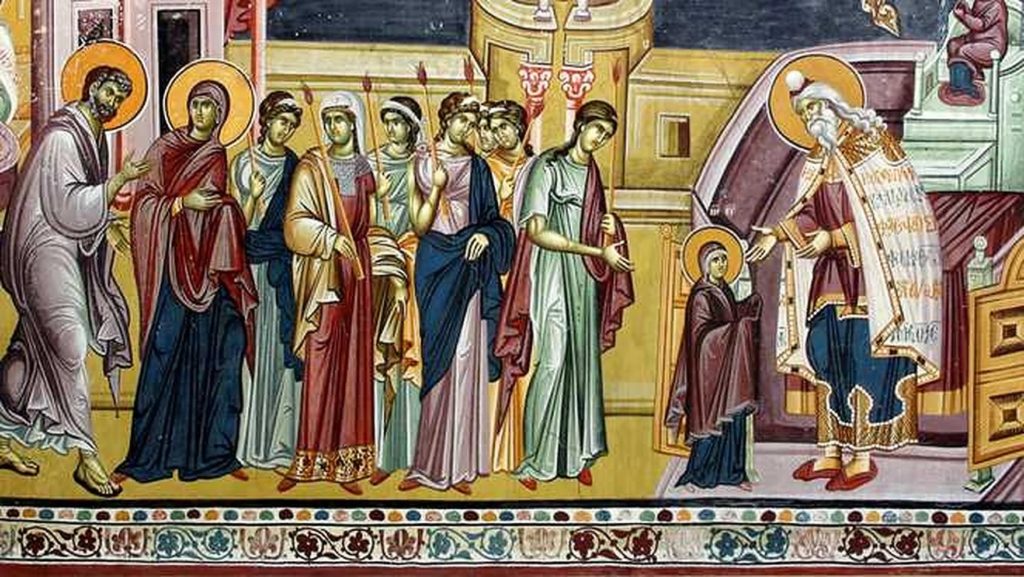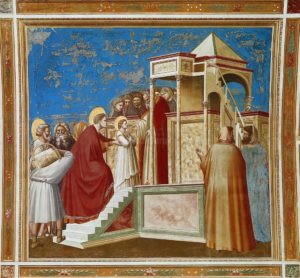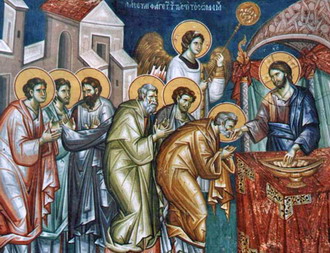 The entrance to the Temple of the Mother of God is the feast that anticipates the great feast of the Birth of our Lord Jesus Christ. Named to the people of Vovidenia or Ovedenia, this holiday reminds of the day when Saints Ioachim and Ana brought their daughter Mary to the Temple of Jerusalem, where she remained until the age of 15. It is the newest feast of the Virgin Mary, celebrated starting the sixth century.
The entrance to the Temple of the Mother of God is the feast that anticipates the great feast of the Birth of our Lord Jesus Christ. Named to the people of Vovidenia or Ovedenia, this holiday reminds of the day when Saints Ioachim and Ana brought their daughter Mary to the Temple of Jerusalem, where she remained until the age of 15. It is the newest feast of the Virgin Mary, celebrated starting the sixth century.
Every year, on November 21, Christianity celebrates the moment when the Saints and Righteous Joachim and Ana brought it to the Temple in Jerusalem and worshiped their daughter, Mary, who became the God-begotten. So Ioachim and Ana fulfilled the promise made in their prayers to God, that if they were blessed with old age with a child, they would give it to Him.
The two were very affected. Because they had no children, they were considered by the society then punished by God. The Holy Fathers and Holy Tradition also speak of an episode in the Temple. A Jew in the tribe of Reuben humiliated the good Joachim while in the Temple, saying, “Why do you bring your gifts before others? You are unworthy, because you do not have children, for who knows what hidden sins. ” Affected by these words, Joachim withdrew to his flock, praying, and Ana went to pray in the garden under a bay. They have now made the holy promise, have asked God the much-desired child, promising to give Him the gift. By listening to the prayers, God sent His angel who told St. Ana that he would have a child. In the work on the life of the Holy Virgin Mary, St. Maximus the Confessor speaks of a deeper sense of the desire of Joachim and Ana to be parents: “They wanted something to be born not only to eradicate their reproach, but also that of the whole world , to bring it to a higher glory. “
 The Virgin Mary entered the Holy of Holies
The Virgin Mary entered the Holy of Holies
When the babe, given by God to elders Joachim and Ana the barren, turned 3 years old, the parents gave it to the Temple of Jerusalem. According to Blessed Jerome, at the entrance to the Temple were fifteen steps, according to the number of the fifteen psalms “of the steps”, so called because at each of those steps was a psalm singing by the priests and Levites who were to serve. When they arrived at the temple, Fathers Ioachim and Ana placed Mary on the first step, and she, immediately and unsupported by anyone, ran up the stairs, quickly reaching the highest, where she stood, reinforced by his grace God. They all marveled, but by divine discovery, only Zacharias, the great archbishop, saw in the infant of only 3 years the one who will be the “Mother of Life”. Thus, Archbishop Zaharia leads the Virgin Mary to the Holy of Holies, the place where the bishop only enters once a year. It did so from the inspiration of God, who was to be born of itself, to the straightening and salvation of the world that was corrupted by sin.
Here, in the Holy of Holies, the Virgin Mary prepared, through the work of the Holy Spirit, to become the Temple of the Living God. Zechariah offered the Holy of Holies as a place of prayer, apart from the other virgins in the temple. Neither they nor those who served in the Temple were able to approach the Holy of Holies because they did not have the blessing of the high priest. While the Mother of God, though tender in age, she was perfect in the gift of God. Here, at the Temple of Jerusalem, there were three rows of cells, dwellings where they lived, fearing God, virgins and widows worshiping the Lord, as well as priests and ministers. The Temple remained until the age of 15, where Saint Archangel Gabriel fed and deciphered the mysteries of the Scriptures, preparing it for the high call appointed by God. St. Maximus the Confessor says in the above-mentioned work that the virgins who accompanied the Virgin Mary represent the virgin souls who, through the intercession of the Virgin Mary, will be led, over the centuries, to eternal happiness in the Kingdom of Her Son.
The entrance of the Lady in the church is an event that marks the fulfillment of three promises. The promise of her parents to consecrate her to the Lord as thanksgiving for their prayers being heard, having a child. The promise made by God Himself through the prophets that he will choose a Virgin to be his Mother. And last but not least, the Virgin Mary is the fruit of the human promise, giving itself to the Lord, becoming the “unborn” or “ever-Virgin” Bride.
The entrance to the Temple of the Mother of God is called to the people Vovidenia or Ovedenia, which in Slavonic means “entrance”. If we continue with the explanation of the names, we remember that Ioachim interprets the “preparation of the Lord” because the Virgin was prepared as the Temple of the Lord, as Saint Epiphany of Constantia says, in a homily about the Holy Virgin Mary. And Ana, in turn, interprets “grace,” because they took a charism to make such a fruit through prayer, and to acquire the Holy Virgin. Mary interprets “Lady,” but also “hope,” for it has begun the Lord, Christ, the hope of the whole world. Mary also interprets the “myrrh of the sea,” because it was necessary to give birth to the immortal Groomsman in the sea, that is, in the world. Great tells the whole world, to whom the Virgin gave him tranquility, born on the lime Christ. “Therefore, the blessed name of the Child worthy of praise of Mary is furthermore interpreted” the enlightened one “, which was enlightened by the Son of God and enlightened those who believed in the Trinity to the ends of the earth. For she is the bride of the Holy Child, the Holy Mother of God Mary, the treasured treasure of the divine order, to which Gavriil said: “Rejoice, the gracious, the Lord is with you.” Gavriil spoke to him, and the Father sent the Holy Spirit as an array of heavens, who turned to the Virgin for the One-Born Son, the heavenly bride whom the Father loved, the Son dwelled, the Holy Spirit loved -a. For this is the bride and the “pantry,” and out of it came the Bridegroom Christ; after the song of the prophet David: “In the sun He has made His place, and He is like a Bridegroom coming out of His chamber” (Psalm 28: 5), “Saint Epiphanius of Constantia says.
 The first celebration in the year 453
The first celebration in the year 453
The newest of the Feasts celebrated to the Virgin Mary, the entrance to the church of the Mother of God is of Ierusalimite origin, born in the sixth century. On November 20, 543, Emperor Justinian the Great (527-565) built a temple dedicated to the Holy Virgin in Jerusalem, near the ruins of the Temple, which, unlike an older one, was called the Church of Our Lady of the New. According to custom, the day after the consecration, that is to say, on November 21, the protector of the church began to be celebrated, that is to say, the Holy Mother of God itself, the feast consecrated to her arrival at the temple. Before the 6th century, the feast was generalized throughout the East. In the West, it was introduced sporadically, probably through the influence of the Greek monasteries in Italy, first in England (the 11th century), then in France, first in Avignon , at 1371. Its generalization throughout the Western Church began in 1472 and was completed in 1585.
